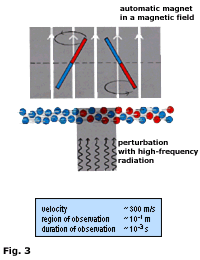Precision measurements using atomic beams and ion traps
|
Physics has the ambition to discover the laws of nature. The predictions of these laws must be checked by accurate experiments. Even very small deviations are of great principal importance and require the highest possible precision in the measurements. The laws of physics are directly or indirectly based on quantities such as mass, length, time and electric charge. |
|
|
Measurements of time are always related to a periodic phenomenon with a certain frequency, e.g., the oscillations of a pendulum or the rotation of the earth. Nowadays our time standard is defined by atomic oscillations. Precision measurements are often realized as measurements of frequency. However, it is not possible to measure the frequency of a periodic event with unlimited accuracy. A frequency band width B necessarily results from a measurement (observation) of duration T (fig. 1). The precision of a measurement will, however, increase with a longer observation time. This year’s Nobel Prize laureates have discovered ingenious ways of increasing the observation time. |
 |
|
Precision measurements can either be made by using atomic beams (N. Ramsey) or particles (ions, elementary particles, etc.) stored in an electromagnetic ion trap (H. Dehmelt and W. Paul). In these measurements resonances are exploited, which means that the probability S of observing a physical event has a maximum at a certain frequency u0 (the resonant frequency). The probability S is given by a bell shaped curve having a band width G (fig. 2). Precision measurements often require that B is much less than G . |
 |
|
Atoms and elementary particles can have magnetic dipole moments meaning that they behave like small bar magnets. However, in a magnetic field they exhibit only a limited number of orientations. The electron and some atoms have only two allowed orientations where the magnetic poles can be imagined as rotating along a circle (fig. 3). High frequency electromagnetic radiation may cause the magnet to flip to the other direction. This flip will occur when the radiation and the rotation of the magnet have the same frequency u 0 (i.e. resonance), requiring an energy change of hu 0 (h = Plancks constant). In an atomic beam the atoms fly through the region of observation rapidly, which thus causes a large band width B. Furthermore, once the atoms have reached the detector they are not available for further measurements. However, Ramsey discovered a method involving two regions of perturbation, resulting in an interference phenomenon which considerably reduces the band width. |
 |
|
The Paul trap and the Penning trap (F.M. Penning, a Dutch physicist) are geometrically similar traps, quadrupole traps. The Paul trap exploits an intermediate (~1 Mhz) frequency a.c. voltage between the hyperbolic ring and the hyperbolic end electrodes. The Penning trap, however, has a repulsive d.c. voltage on the end electrodes and a strong magnetic field in the axial direction. In the ion traps the cloud of charged particles, either created in the trap or introduced from the outside, is located in a very small region. The size of the region decreases with the kinetic energy. It is even possible to observe one single particle trapped during a long time. In the trap the particle can be subject to repeated and controlled perturbations with subsequent observations, which leads to a small band width and extremely precise results. Measurements with single particles of the same kind show with a large accuracy that they have identical properties. |
 |
Nobel Prizes and laureates
Six prizes were awarded for achievements that have conferred the greatest benefit to humankind. The 12 laureates' work and discoveries range from proteins' structures and machine learning to fighting for a world free of nuclear weapons.
See them all presented here.
